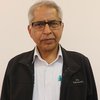"Everything there is in the world exists to be put in a book."
Ste'phane Mallarme', French poet, c.1880
The quote above indicates that knowledge and wisdom not collected in a book is likely to be wasted. Sooner it is done the better. Hemang Dixit, professionally a medical man with expertise to cure children, is undoubtedly one of those few Nepalis who understood the French poet's message fairly early. Or else he would not have written these many books---with the present title, teen kitap, being his latest contribution. The list of the books, both technical and non-techincal-- he has authored thus far is printed in the present publication, and it shows his first book was published in late 1960s. The fact that he is a prolific writer is also substantiated by the numerous topical newspaper articles he has written in preceding years. After all, Dixit belongs to the noble family of Mani Acharyas.
" Teen kitap " (or three books) is an anthology of three Nepali language books printed a hundred years ago. Two of them, Shishubodhini part 1, and Sisubodhini part 2, came out in 1911, and "Gorkhavyakaranbodh" in 1913. The first two booklets were apparently aimed at children being introduced to Nepali letters while the third one, spreading over 190 pages, is a book of Nepali (the language was sometimes called Gorkhali) grammar. The author of grammar book is Biswamoni Dikshitacharyya; the first of the other two was written by Khecharmani, and second book is credited to Pundit Lekhnath Paudyal who later became one of three great literary figures of Nepal ; Laxmiprasad Devkota and Balakrishna Sama being the other two. The first of the two first books appears to have been designed to teach young boys ( and girls if any in those days ) single Nepali letters, not combined or conjugated letters and words. In fact, those letters were kept for Shishubodhini part 2. The importance of these books for Nepali language and literature has been succinctly explained, in Nepali, in the foreword written by Sarat Chandra Wasti, an eminent journalist, whose authoritative knowledge of Nepali language and grammar is widely recognised.
What, incidentally, prompted Biswamoni to write a grammar book exactly a hundred years ago ? Hemang Dixit has offered the context : that Nepal's first college, Tri-Chandra, was seeking affiliation with Calcutta University. Nepali language was not yet recognized by that university and authorities there ostensibly complained that the language did not have a grammar or a dictionary. It was at that time when " ….Biswamoni was motivated and pushed by Ram Mani to produce Gorkhavyakaranbodh." A related point needs to be understood here, as is mentioned in the foreword by Kamalmani Dixit, that first Nepali grammar, ironically in English, was written by J A Ayton almost a hundred years before. Similarly, when the references to dictionaries are made, Ralph Lilley Turner's "Dictionary of Nepali Language" ( 1931 AD ) is invariably cited. And he has acknowledged, in the preface, the contributions made by " …my friend Pandit Dharanidhar Sharma Koirala, B. A. B. T. , of the Government High School, Darjeeling…" A detailed description about this contribution can be found in the book on Koirala himself by late professor/scholar Jagannath Sharma Tripathi.
"Teen Kitap", if fact, has its fourth dimension in the form of accompanying write-ups of Dr Hemang Dixit himself. These consist of information, supportive arguments often with compelling evidence. The Gurkha connection in the gradual and steady development of Nepali language can be a case in point. Examples of grammar book and dictionary are there, but these alone are not the factors that establish how the British connections helped popularise Nepali language among the Gurkhas coming from diverse ethnic groups. It is in this background Dixit says, " It is totally wrong to say that the Nepali language was thrust on the various tribes or the indigenous peoples of Nepal." The writer also alludes to the history when first efforts were made to translate the Bible into Nepali language.
What might have encouraged Dr Dixit to travel to the far-away land of a language ? The answer can be found on the page where pays tributes to his parents. He has dedicated the book also to his grandchildren as he wants them " to know their roots ".
- Treacherous Trajectory Of A Refugee Kind
- Jul 09, 2023
- Can One More Election Help Nepal To Be Stable ?
- Dec 27, 2013

















